|
The Glenthorne Authority
locomotives |
The Glenthorne Harbour Authority always ploughed
their own furrow, ordering two 2-6-2 Hunslet locomotives which were the
precursors to the successful 'Russell' delivered to North Wales in 1906.
These engines, No. 1 and No. 2 were slightly more powerful than the later
'Russell'.

Hunslet No 1
at Chelfham
As the harbour traffic increased, it became
clear that an additional locomotive was needed. In 1906, they purchased from
Baldwin, USA, at very good terms, a 2-6-4 tank locomotive which became the
only locomotive to carry a name; 'Ben Halliday'.
Hunslet No.2 was damaged beyond repair in a serious rock fall accident when
entering Glenthorne Harbour in April 1912. The Baldwin was then numbered No 2.

The Glenthorne Baldwin was shipped to
Plymouth and travelled by rail to
Barnstaple where it was craned onto the track.
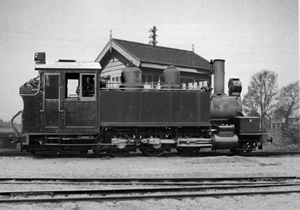
Here, the new locomotive stands
resplendent on its new metals.
In 1910, two 0-4-0-0-4-0 Garratt locomotives were purchased (no 4 & 5). These
were developments of the compound K1 Garratts supplied to Tasmania the
previous year. They were chosen to handle heavier loads up the steep winding
grades from the port. The Garratts handled the task well but were notorious
for damaging the track. It would appear that the wheelbases of the power
bogies is too short which results in 'hunting'.
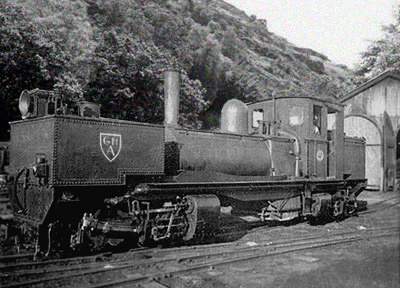
Garratt No 5 at Porlock engine shed

one of the Garratts climbing
up from the harbour
Glenthorne
locomotives on the main line
The traffic generated by the Glenthorne harbour
was the mainstay of goods on the main line. Frequently, Southern was unable
to supply sufficient motive power to operate their requirements. A joint
running agreement resulted in Glenthorne locomotives operating on the main
line. On occasion, the more powerful Glenthorne engines are even seen on
special passenger workings.
Later locomotives
The Harbour Authority operates two very
different branch lines. The Harbour branch is extremely steep and only heavy
locomotives can deal with the growing traffic. The branch to Porlock is
relatively flat and lighter locomotives suffice.
The company now operates the most powerful
narrow gauge locomotives in Great Britain. Often the company purchases large
colonial locomotives that have been left on the makers hands. This has
necessitated the easing of some curves and the relaying of the harbour
branch in heavier rail.

Aerial photo of No 7
Hudswell Clarke crossing Waterfalls viaduct on the sea cliffs circa 1933
photo by kind permission of the Whitmore estate
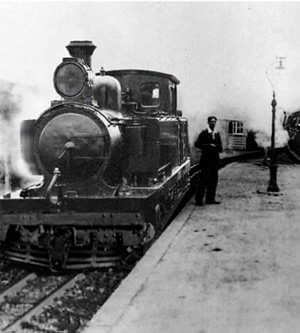
The Kitson Meyer at Lynton -
photo L.T.Catchpole
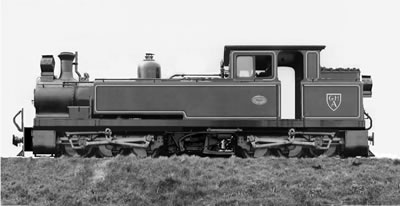
Kitson Meyer - photo L.T.Catchpole
- click on image to enlarge
After the Great War, two ex WD
locomotives were purchased for very little money, although they are not
very7 popular or successful and were used for shunting duties for the
most part. Both remaining locomotives are now withdrawn. During my visit, this year, Garratt (no.4), Hunslet
(no. 1), Baldwin (No.2 ‘Ben Halliday’), Kitson Meyer No.6,
Hudswell Clarke No7, Kerr Stuart No11 and North British No10 were in use. The Alco No 8 had been overhauled at Pilton Yard over the
winter of 1930 but failed in 1934. Garratt No.5 (whose boiler had been
condemned) and the mortal remains of Hunslet No.2 lie dismantled and raided
for parts at Doone Sidings while No 8 is rusting away at County Gate engine
shed. Baldwin No 9 was deemed surplus to requirements and has been shunted
into a siding at the Harbour.

no.9 4-6-0 Baldwin; now withdrawn.
The easy grades of the Porlock Branch are more
friendly to ex WD locomotives until they were withdrawn this year. During our visit in 1935, local traffic was being being worked by
the
No 2 Baldwin and ex main-line railcar No 201.
Coal transfer from Glenthorne Harbour is being undertaken with the Garratt No 4,
Hudswell Clarke Mikado (No 7) and the Kitson Meyer. Ben Halliday and the Peckett (No
12) are
handling general goods. Other heavy locomotives in use are North British
Pacific (No 10) a Kerr Stuart tender
locomotive (Mikado) (No 11), a massive 2-8-4 tank engine by Hunslet (No 14)
and a 2-6-4 Kerr Stuart tank (No 15).
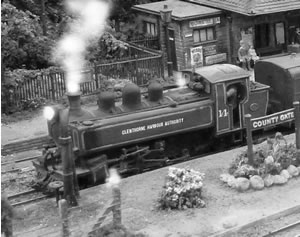
Hunslet No 11 (photo by
author)
In 1929, a new diesel power unit was delivered
to replace steam traction for summer passenger services on the Harbour Branch. This was built locally using two Gardner engines.
One engine was used for each direction as the gearboxes only had one reverse
gear. The unit has proved to be less than reliable and it is not
unusual to find the original push pull coaches being pressed into service
with a steam locomotive.
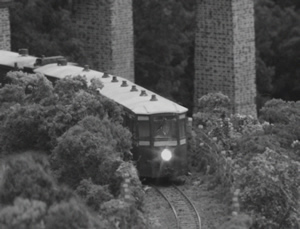
the original Glenthorne
railcar
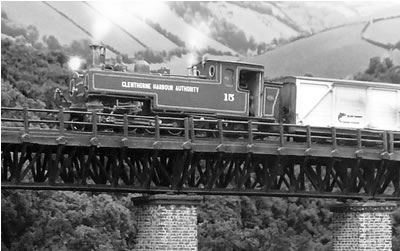
Kerr Stuart 2-6-4 No 15
crosses the Glenthorne Viaduct. (photo by author)
In 1935, the original prototype railcars on the
main line became surplus to requirements after the new series of railcars
were delivered. These have been purchased by the Glenthorne Authority for use
on both of their branches. This was followed by the purchase of railcar 302,
needed to strengthen the harbour branch passenger service.
Unseen by myself, is the new diesel traction
locomotive built as a joint venture between Southern Railway and the Harbour
Authority.
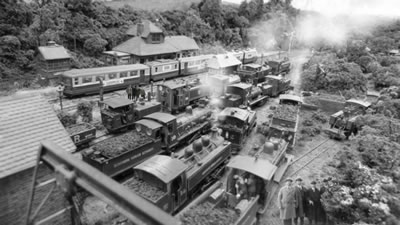
Glenthorne Harbour
Authority locomotive fleet
|
Glenthorne
Locomotives |
|
Name/number |
year built |
withdrawn |
Type |
Manufacturer |
|
No 1 |
1902 |
- |
2-6-2T |
Hunslet |
|
No 2 |
1902 |
1912 |
2-6-2T |
Hunslet |
|
No 3 (later No2) 'Ben Halliday' |
1906 |
- |
2-6-4T |
Baldwin |
|
No 4 |
1910 |
- |
0-4-0 0-4-0T |
Garratt |
|
No 5 |
1910 ex WD |
1929 |
0-4-0 0-4-0T |
Garratt |
|
No 6 |
1918 |
- |
0-6-0 0-6-0T |
Kitson Meyer |
|
No 7 |
1917 |
- |
2-8-2 tender |
Hudswell Clarke |
|
No 8 |
1918
ex WD |
1934 |
2-6-2T |
Alco |
|
No 9 |
1917
ex WD |
1935 |
4-6-0T |
Baldwin |
|
No 10 |
1912 |
- |
4-6-2 tender |
North British |
|
No 11 |
1914 |
- |
2-8-2 tender |
Kerr Stuart |
|
No 12 |
1930 |
|
0-6-0T |
Peckett |
|
No 14 |
1933 |
- |
2-8-4 T |
Hunslet |
|
No 15 |
1924 |
- |
2-6-4 T |
Kerr Stuart |
|
No 16 |
1926 |
- |
2-6-2 T |
Chittaranjan Loco. Works |
|
No 20/21 |
1935 |
- |
bo-bo,bo-bo |
Southern Rly/Glenthorne |
|
harbour railcar |
1929 |
- |
railcar |
built locally |
|
No 200 (ex Southern) |
1932 |
- |
railcar |
Eastleigh |
|
No 201 (ex Southern) |
1933 |
- |
railcar |
Short Bros. |
|
No 302 (ex Southern) |
1933/4 |
- |
railcar |
Eastleigh |
Harbour locomotives are painted in maroon with
black and yellow lining. Ex WD locomotives are not usually lined. The
exception is No 6, the Kitson Meyer, which for some reason has always
appeared in lined black.


|